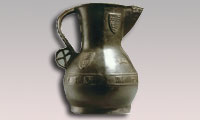Wenlok jug facts for kids
The Wenlok Jug is a very special bronze jug from the 1400s in England. It's important because it helps us learn about how people made things from bronze a long time ago. There are only two other similar jugs known in the UK. The Wenlok Jug is the smallest of these three, but it has the oldest mark from the person who made it. This person might have been a bell maker!
Contents
Discovering Ancient Jugs
The other two jugs are the Asante Ewer and the Robinson Jug.
- The Asante Ewer still has its lid. It was found in Ghana in 1896 during some wars. Now, it's kept at the British Museum.
- The Robinson Jug was found in a farmhouse in Norfolk in 1879. You can see it at the Victoria & Albert Museum.
All these jugs have English writing on them. They were made from a metal mix called leaded bronze, which is copper, tin, and lead. They were cast (poured into a mold) in a similar way, using two parts for the mold. They also have similar decorations.
What Makes the Wenlok Jug Special?
The Wenlok Jug is about 31.5 centimeters (about 12 inches) tall and weighs 6.1 kilograms (about 13.5 pounds). It has words carved into it that say "My Lord Wenlok."
Decorations and Symbols
The jug also has several old symbols:
- The Royal Arms of England: This was the official symbol of the English kings from 1340 to 1405.
- The three crowns of East Anglia: These crowns are linked to St Edmund and St Etheldreda, who were important figures from East Anglia.
The jug once had a lid, but it's missing now. You can still see the hinges where it used to be.
Who Owned the Wenlok Jug?
People think the jug was made for William Wenlock (who passed away in 1391). He was an important church leader at St Paul's Cathedral and Westminster Abbey. He is buried in Luton. It might also have been made for his great-nephew, John Wenlock, 1st Baron Wenlock. John had a large brick house called Someries Castle near Luton.
The Jug's Journey Through Time
By 1831, the jug was owned by Thomas William Fermor, 4th Earl of Pomfret. It might have been bought by a collector named Henrietta Louisa Fermor.
A Big Sale and a New Home
In 2005, the jug was sold at an auction by Alexander Fermor-Hesketh, 3rd Baron Hesketh. It was part of a sale of items from Easton Neston house. The jug sold for a huge amount of money: £568,000! This was six times more than what experts thought it would sell for.
The Metropolitan Museum of Art in New York wanted to buy the jug. However, a temporary ban on sending it out of the country allowed Luton Museum to raise enough money to buy it instead. They raised £750,000 with help from many groups, including the National Art Collections Fund and the National Heritage Memorial Fund.
Stolen and Found!
The Wenlok Jug was shown at the Wardown Park Museum and then at the Stockwood Discovery Centre in Stockwood Park in Luton. Sadly, it was stolen from a very secure display case on May 12, 2012.
After the theft was featured on the BBC show Crimewatch, the jug was found in September 2012 in Surrey. It was safely returned!
Another Idea About the Jug's Origin
Some people have a different idea about where these three jugs came from. They suggest that all three jugs were made in or near Bruges (a city in Belgium) in July 1468.
This theory says that Charles the Bold, a powerful ruler, gave the jugs as gifts. He gave them to the people who traveled with his new wife, Margaret of York. Margaret was the sister of King Edward IV of England. The gifts were for:
- Sir Anthony Woodville (who got the Asante Ewer)
- The Duchess of Norfolk (who got the Robinson Jug)
- Lord John Wenlock (who got the Wenlok Jug)
This idea suggests that Margaret of York herself came up with the English words on the jugs. The old symbols on the jugs might have come from the household of Charles the Bold's aunt. If this theory is true, then the jugs are examples of amazing craftsmanship from a region called Burgundy in the mid-1400s.


